Peter and Ariana:
October 15th, 2012
October 15th, 2012 was the first full day of excavation at the Quiet Green site on the west face of Hope College for the Archaeology of College Hill class. It was decided that we would form two groups for the day. The first group would begin excavation on our first trench, QG#1, and the second would work with both the total station and do geophysical survey with the ground penetrating radar.
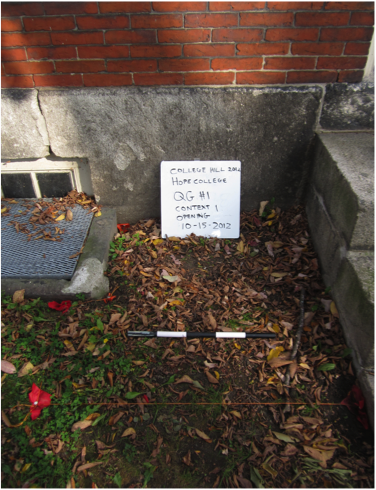
We began excavating our first small, 1m x 1m trench, labeled QG#1. It is located just north of the central stairs leading to a now inactive door on the west side of the building facing the Quiet Green and is situated right next to a window egress. It had been raining the previous weekend so the soil was damp and dark. The team began by clearing off the trench of debris, including leaves, trash, and weeds.
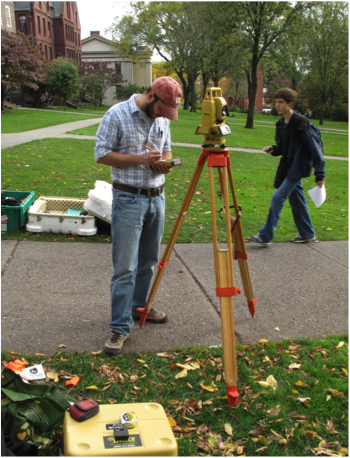
After clearing the trench, we opened context #1 by initially taking points of the trench with the total station. The total station measures using laser refraction. To operate the total station, we measured the total station’s distance from a known location (obtained from the Rhode Island state government) to establish the location of the total station in three dimensions. From there we measured the distance to specific trench locations.
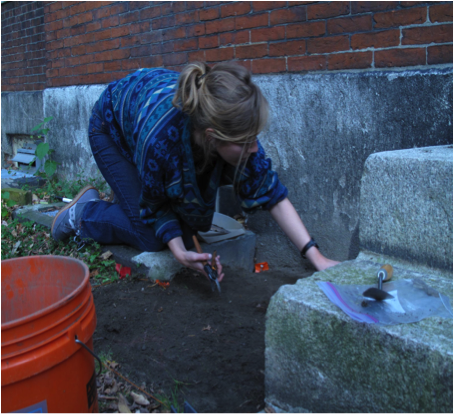
We began unearthing context 1 through trowelling which revealed lots of broken glass. We also uncovered some ceramic fragments and a metal bullet casing. Finally, we cleared the context by cutting many of the small roots. We then closed context 1, the topsoil layer. All fill from this layer was sifted with ¼” mesh.
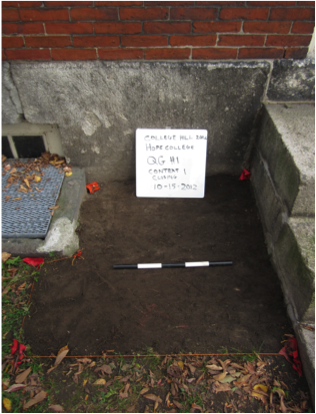
Context 2 was the layer beneath the topsoil and similarly had a dark brown color and was characterized by a change in consistency a few layers down because of the wetness. The context was trowelled to begin with for approximately 2-3cm. There were continued glass finds and much removal of roots. After trowelling a few (2-3cm) further it had become apparent that the northeast corner of the trench had drier soil and created a crevice next to the window egress foundation. Fragments of brick construction material and a penny with a mint date of 1976 were discovered in the fill. At this point we shovel shaved further into the context noticing no apparent change in soil composition. We cut out a large root running north to south in the middle of the unit and found several pieces of numbered ceramic. One piece had the letters “AUG” which someone one the team suggested could be the fragmentary word “AUGUST,” the numbers indicating a calendar. All fill from this layer was sifted with ¼” mesh and bags for metal, ceramic, and glass were collected. Finally, we closed the context as we did previously, and finished excavating for the day.
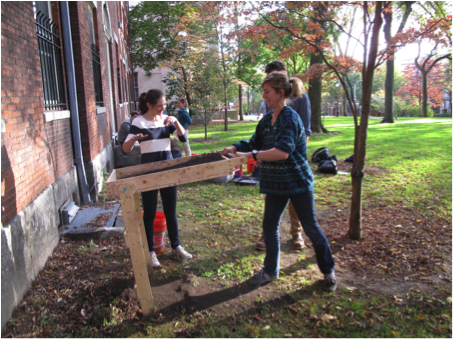
The group operating the Ground Penetrating Radar worked with Tommy Urban to try to determine the location of the original President’s House. First we set up two parallel lines, squaring them off of one another using the Pythagorean Theorem and 3-4-5 triangles. Then we took turns dragging the GPR back and forth between the lines. The person pulling the GPR wore a harness with a screen, displaying the results of the GPR in real time. We moved back and forth in ½ meter transects covering an 18m X 18m area. After we completed collecting the data, we measured the four corners of the area using the total station.
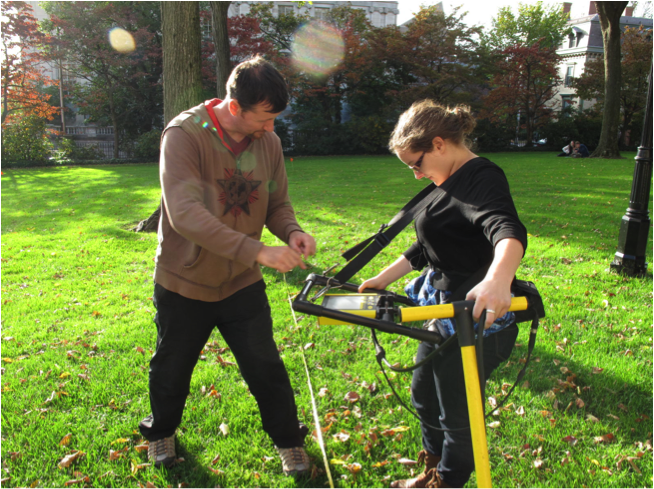
This data was then analyzed using software associated with the GPR and converted into a video file (which can be found on the course wiki). In this video file, a quadrilateral object appears at the approximate location given for the President’s House on the Plat used in our initial research. It was located approximately 1.5 meters underground. We hope to open a test pit in this location in a future class meeting.
October 20th, 2012
Excavation resumed on October 20th, 2012 in conjunction with Brown University’s Family Weekend and National Archaeology Day. Some members of the class volunteered to continue excavating while community members could stop by to learn about the project and participate.
It had been raining fairly heavily and the trench had puddle and the soil was extremely muddy, dark brown and wet. Context #3 was opened and it is the same muddy soil layer with frequent as Context #2. Thus Context #2=Context#3. Context #3 was trowelled and fill was shifted with ¼” mesh. Finds were fairly similar, including glass, ceramic, and metal to Context #2. There were some corroded nails, a faunal bone, another bullet casing of the same type found previously, as well as shale or slate and charcoal. One point to note is the discovered of slate concentrated along the edge of the stairway, the southern side of the trench, running throughout east to west. One suggestion was that this was part of the old walkway. A bag of slate samples was saved and the rest discarded. The context was closed with points from the total station.
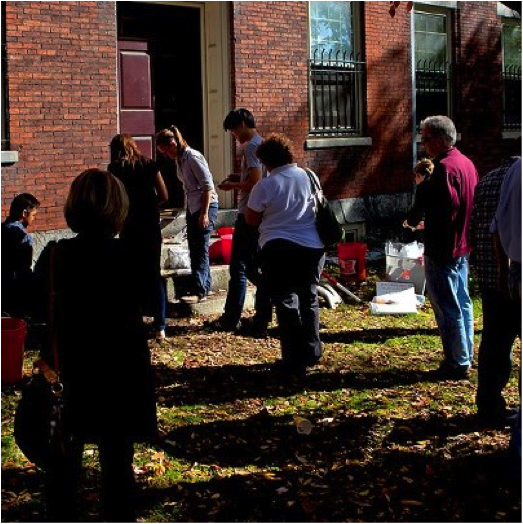
Next, Context #4 was opened with the soil drier than the previous context and yellowish red gritty soil. There was a similar artifact distribution as Context #4 and bags were collected for glass, ceramic, charcoal, and metal. One artifact of note was a piece of ceramic, which was thought to be a pipe fragment. All fill was sifted with ¼” mesh. In the northeast corner a small spot of greenish-grey chalky crumbling soil was noted. The concentration of shale continued to be present on the southern edge of the trench and a deeper area in the middle in the trench, tending towards the eastern side was becoming defined. The context was closed at the end of the day, although not completely finished and work would resume in context #4 the following Monday.
Fieldwork Summary for October 22, 2012
Christopher Thompson and Caitlin Deal
Today Chris Kim was charged with taking pictures throughout the class period, mostly of contexts being opened and closed but also some of the work in progress.
A team consisting of Caitlin Deal, Ariana Gunderson and Peter Johnson worked with Linda on the continuation of Context 4 of QG 1, which some students had also worked on during Family Weekend.
A line of rubble was evident along the south end of the trench near the stairs, so as we tried to reach the lighter-colored soil of a new context, we also defined the individual stones. These stones turned into a pile of rubble that was termed Context 5. After photographing the stones, we removed them and the level underneath became a part of Context 6.
During the digging and sifting of Context 4, we had one bag for ceramics, one for glass, one for metal, one for the metal bullet, one for pieces of charcoal, and one for plastic items. The piece of plastic looks like it came from a comb, indicating that we are not yet so far into the ground that, when the items were deposited, plastic was not a popular material. The metal pieces that do not include the bullet casing are probably nails, and students are still coming up with different theories of how the bullet casings ended up in the trench, as this is the third one. There were a few pieces of particularly interesting ceramics that were different colors (blues, white, and black), and some were patterned. Most of the glass pieces were too small for us to conclude anything at their discovery, but there were a few pieces that were light green in color. Another piece that we found just before the end of class (and the closing of Context 4), was tubular in shape and larger than any of the other pieces that we had previously found. As we worked through Context 4 we could also see a long, curved, purple object within Context 6 that, unfortunately, we did not have time to excavate. Another unusual discovery was that of a hole in the southeast corner of the trench that appears to be relatively deep, which quickly got larger as we learned that the rocks and dirt around it easily came away. The hole can be seen in the picture below, near the bottom-left corner of the whiteboard.
Contexts 4 and 5 were officially closed by the end of class.
A second team opened Trench #2. This team consisted of Christopher Thompson, as recorder, Joey Mallen, Christina DiFabio, and Caity Mylchreest under the supervision of Alex Knodell. The trench is situated approximately five feet from the base of the stone steps that lead up to the western entrance (now defunct) of Hope College. The trench straddled what we assumed would have been the location of a path exiting the dormitory.
The second trench is labeled GQ #2, indicating trench #2 on the “Quiet Green.” It is 1 meter by 1 meter. The total station coordinates corresponding to the northeast corner of the trench is point 46, to the southeast corner is point 47, to the southwest corner is point 44 and to the northwest corner is point 45. Morgan Albertson took the total station points.
Excavation began. Within the first couple of centimeters we found three pennies dating from 1975, 1980, and 1982. The third penny was found in the southeast corner of the trench and is pictured below.
There was an extensive root network of small roots, as well as several thicker ones, which were cut with larger shears. The soil was consistently compact below the first couple of centimeters of soil, and had to be scraped away. We used a sifter with ¼’’ mesh and found many pieces of glass, some pieces of plastic trash including a striped plastic straw, a few small pieces of ceramic, a nail, and a shell.
The discovery of a greater concentration of objects prompted us to close context #1. Of particular interest we found directly east of the center of the trench a piece ceramic with blue design. It was bagged as “ceramic.”
We opened context 2.
Time limited us to a few centimeters of excavation of context #2. Extensive roots still crisscrossed the trench and had to be cut away. There was a greater number of small rocks and glass fragments than in the context #1. We found a stone that looked similar to obsidian, although Alex Knodell expressed doubt of it actually being obsidian. We ended the excavation soon after, as the class was over for the day. The trench was covered in a plastic tarp.
Fieldwork Summary for November 5, 2012
Eddie Cleofe
Morgan Albertson
Excavation for the week of October 29th was canceled because of hurricane Sandy, which resulted in strong winds and heavy rain in Providence. We were able to continue with our excavation on the Quiet Green on November 5th.
Pete Johnson was in charge of taking photos this week. For QG2 he took one photo facing south for the closing of context 2 and opening of context 3. For QG1, Pete took six photos, all facing east. These included the opening of context 6, two photos of pipes found within context 6, two photos of the closing of context 6, and the closing of context 7.
Ariana Gunderson, Peter Johnson, Caitlin Deal, and Chris Kim all worked on QG1 this week under the supervision of Linda Gosner. Excavation began with the opening of context 6.
Because of the hurricane, the trench was significantly more moist and full of leaves as compared to our previous field days. The soil in context 6 was characterized as sandy with many small pebbles. The excavators continued finding pieces of ceramics and glass, however the amount of glass was much less than in previous contexts. Pieces of large, glazed, purple ceramic were found and identified as a part of a ceramic pipe, most likely used for the flow of water. These large pipe pieces were scattered throughout the context. While slate has been found in previous contexts, the slate fragments found in context 6 are very large and are possibly from the old roof of the building. A lot of small pieces of charcoal were also found in context 6. Finally, the team this week found pieces of cigarette butts, the white fibrous part, in context 6. It is unclear at what rate this material degrades but the presence of organic material may indicate significant disturbance even in this layer. As the soil became gray in color with lots of pieces of rocks and brick, the team closed context 6 and opened context 7.
Morgan Albertson and Christina DiFabio took closing points with the total station of context 6 closing.
The soil of context 7 is brown with lots of gray streaks throughout and had many rock, charcoal, and brick inclusions. There was not enough time to start digging context 7 however the hole in the southeast corner of the trench was identified as a feature in this layer. We will continue to work on this layer next week.
QG2 was similarly affected by Hurricane Sandy. The tarp itself was covered with a layer of wet leaves, and its removal revealed moist soil topped by more leaves. The excavation team for QG2 was composed of Caity Mylchreest as recorder, Joey Mallen, Chris Thompson, and Eddie Cleofe. Excavation began with manual removal of the leaf layer. With the bottom of the trench properly exposed, Chris Thompson and Joey Mallen removed a top layer of soil with shovels in order to more quickly excavate. Caity Mylchreest and Eddie Cleofe sifted the resultant backdirt.
Sifting revealed the same types of material culture as found in previous contexts, namely glass shards, ceramic bits, and the occasional rusty nail. A few more centimeters of digging through heavily rooted revealed the flat face of a large rock and the top of a modern irrigation pipe. Both objects were excavated around using a technique known as pedestaling, thereby leaving the soil beneath untouched and the objects where they were initially buried.
The Total Station Team, composed of Morgan Albertson and Christina DiFabio, walked the probable line of the exposed pipe and located a control valve cap. The cap was totaled in as a further reference point.
Some noteworthy items found in Context 2 are a shell and an unidentified nail or stake that has been filed to a point.
As QG2 continued to be excavated, the soil at the bottom of the trench started changing in color and consistency. The soil, now more yellow and with more clay present, was the first true dramatic change in soil qualities—Context 2 was opened due to a sharply noticeable increase in artifact density.
QG2 was excavated until its entire floor was composed of the same new soil type. The Total Station Team totaled in six points, four corners and two interior, and the trench was photographed and closed.
By 5pm the sun was setting and it was getting to dark for excavation, therefore we closed the trenches and covered them with the tarps and flagged the corners.
November 12, 2012: Joey Mallen and Caity Mylchreest
Morgan Albertson and Christina DiFabio worked to set up the total station. When the setup was finished, they joined the excavation teams; Morgan working on QG #1 and Christina on QG # 2. They took measurements at the end of the day, which are noted in the project field survey journal.
Ariana Gunderson, Peter Johnson, Caitlin Deal, and Chris Kim all worked on the trench Quiet Green #1 (QG #1) this week under the supervision of Teaching Assistant Linda Gosner. Excavation continued on Context 7 that was opened a week prior on November 7, 2012.
The soil in Context 7 was gray in color with many of pieces of rocks and brick. The excavators continued finding pieces of ceramics and glass, however the amount of glass was much less than in previous contexts. In this context excavators continued to find of large pieces of glazed ceramic. It can be assumed that these pieces are the remains of a ceramic pipe that was possibly used to supply water to the building. These large pipe pieces were scattered throughout this context; they were collected and placed in context bags.
Team members also continued to find pieces of grey slate fragments in Context 7. While slate has been found in previous contexts, the slate fragments found in Context 7 are significantly larger than before and are very similar to those that cover the roof of Hope College. Due to the trench’s proximity to the building, it is a definite possibility that these fragments are simply bits of old roof shingles that have fallen to the ground. Many small pieces of what was determined to be charcoal were found in Context 6 but upon further review it seems possible that these are pieces of asphalt based off of the smell of oil that they emit. Pebbles, rocks, brick fragments, and asphalt chunks dominate Context 7. It can be guessed that this layer is a layer of fill dirt or left over debris from the renovation of Hope College in 1959. Fill dirt could have been used on the Quiet Green to cover an old path. This layer of fill would have then be covered with debris filled dirt and sod laid over it.
Fill dirt is often brought in from another location therefore materials not native to the trench location can be distributed throughout the layer. Because of the presence of Brick fragments it my also be possible that this layer was the result of the renovation of the building in 1959. The building was heavily altered and it is possible that we have simply hit the layer or construction debris. Articles found in this context on November 12 include a piece of ceramic with blue deigns on it, more larger pieces of brown glazed ceramic, and a large piece of unidentified corroded metal.
Caity Mylchreest, Joey Mallen, Eddie Cleofe, and Chris Thompson continued work on Quiet Green Trench #2 (QG #2) this week and began Context 3 after discovering a rocky sandy layer at the end of last week’s excavation. Christina DiFabio helped in the team’s progress when she was not working at the total station, and Alex Knodell oversaw the trench’s operations.
Digging in context three began on November 12 due to a change in soil quality from aerated, rooted, and uniformly dark to a lighter, rockier soil. This change in soil type can bee seen in the opening level photos, labeled Closing Context 2 (photos 1367-1369). The digging method continued to rely primarily on troweling, however more shoveling was used than past weeks due to a requirement to close up the trench more quickly, since this is the last week of official, class-time excavation. Time needed to be made up from the missed class due to Hurricane Sandy.
Artifact discoveries remained similar to past weeks in type and definitely diminished in quantity due to a lower level and the out of the way location of the trench with respect to the Hope College Entrance. This confirmed prior hypotheses that more debris would be found at lower depths in QG#1 than QG#2 due to the disposal of debris and trash near a key door of the building. Only a few pieces of ceramics and glass were found through sifting in QG#2, a noticeable decrease from last week’s excavation, and these pieces seemed to diminish in size as they now remained scattered in this context level instead of grouped with similar artifact types, such as a collection of similarly colored glass in varying sizes, in the previous two contexts. However, the team of QG#2 did find lots of gravel and brick chips, which spurred questions as to possible construction backfill from the many renovation projects that occur on the landscape of the Quiet Green. Also, a few chunks of asphalt were found and confirmed by a burnt smell. Most of these pieces were discovered off center in roughly the southwest corner of the trench. Also, as the team began to clear away the loose rocky layer, a possible layer of slate was discovered in the southeast corner.
Context 3 was closed at the end of excavation today due to the discovery of a flatter, smoother rock layer, as opposed to the collection of loose pebbles and sand found throughout context 3. Excavation had to stop sooner today due to it getting darker earlier, and it became difficult to distinguish between change in soil types and the appearance of artifacts. It is possible that Context 4 will be opened on an optional Saturday excavation. This would certainly help to conclude activities in QG#2 effectively and provide interesting points of comparison with the introduction of this new, seemingly solid rock layer. Also, this would help the excavation team to make more educated hypotheses about the existence of a prior marked path on the Quiet Green that now remains buried in QG#2 at a lower level. This might help to explain the increase in rock layers as the context numbers increase.
Class time will now be reserved for analysis of artifacts found in the past month of excavation to complete object reports for final projects. If the teamwork that has defined the project so far continues, all research for final reports is sure to be a cooperative, smooth effort.
Please see word file below for a copy of the Field Summary and the pictures that go with it.
 October 22 Field Summary.docx
October 22 Field Summary.docx